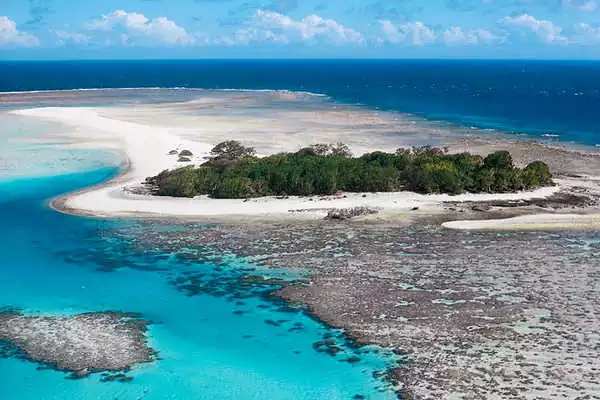Imagine a vibrant underwater tapestry teeming with an astonishing array of life forms. Welcome to the Great Barrier Reef, the world’s largest coral reef system and one of Earth’s most awe-inspiring natural wonders. Stretching over 1,400 miles along the northeast coast of Australia, this underwater paradise is a sanctuary for countless species of fish, corals, and other marine life.
The Great Barrier Reef: A Natural Wonder
Stretching over 2,300 kilometers, the Great Barrier Reef is a breathtaking masterpiece of nature, holding the distinction of being the largest coral reef system on the planet.
Formation and History
The formation of the Great Barrier Reef is a captivating tale that dates back millions of years. It all began with tiny organisms known as corals, the architects of this underwater paradise. These minuscule creatures possessed the remarkable ability to secrete calcium carbonate, a substance that accumulated over time to form intricate structures known as coral reefs.
As these structures grew and expanded, they provided a haven for countless marine species, fostering an extraordinary ecosystem brimming with biodiversity. The Great Barrier Reef, as we know it today, is a testament to the enduring power of nature’s craftsmanship, a vibrant tapestry of life that has evolved over eons.
The Great Barrier Reef’s foundation dates back to the Devonian period, approximately 400 million years ago. Over time, the reef has undergone multiple cycles of growth and erosion, shaped by the relentless forces of nature.
During periods of lower sea levels, the reef emerged above the water, forming vast limestone platforms. As the seas rose and fell, the reef responded accordingly, constantly adapting to its ever-changing environment.
Around 25 million years ago, the Australian continent drifted northward, creating the ideal conditions for the Great Barrier Reef to flourish. Warm, shallow waters and an abundance of sunlight fueled the reef’s growth, allowing it to expand and diversify into the vibrant ecosystem we witness today.
The Great Barrier Reef is a dynamic and ever-changing environment, influenced by complex interactions between various organisms and their surroundings. The reef’s intricate food web supports a staggering array of marine life, from tiny plankton to majestic whales.
The reef’s ecological significance extends far beyond its breathtaking beauty. It acts as a natural breakwater, protecting the coastline from erosion and storms. Additionally, the reef provides a vital source of food and income for local communities.
However, the Great Barrier Reef faces numerous threats, including climate change, pollution, and overfishing. Conservation efforts are underway to safeguard this natural treasure for future generations.
## Life on the Reef
Nestled off the coast of Australia, the Great Barrier Reef buzzes with an astonishing variety of marine life. From vibrant corals to shimmering fish and graceful mollusks, this underwater paradise is home to a dazzling array of over 1,500 species.
## Coral and Algae: A Symbiotic Harmony
At the heart of the Great Barrier Reef’s allure lies a fascinating partnership between corals and algae. This mutualistic relationship is essential for the reef’s survival and captivating beauty.
Corals, tiny marine invertebrates, form the structural foundation of the reef through their calcium carbonate skeletons. They create intricate formations that provide shelter and breeding grounds for countless other species. Within their tissues dwells a microscopic alga known as zooxanthellae.
Zooxanthellae, in turn, benefit from the coral’s protection. They photosynthesize, using sunlight to produce oxygen and sugars essential for the coral’s nourishment. The corals, in return, provide the algae with a stable environment and nutrients necessary for their growth and proliferation.
This symbiotic dance results in the vibrant colors that characterize the Great Barrier Reef. The zooxanthellae’s photosynthetic activity produces specific pigments that give corals their dazzling hues, transforming the reef into a kaleidoscope of underwater life.
Threats to the Reef
The Great Barrier Reef, an awe-inspiring natural wonder, faces a myriad of threats that jeopardize its pristine beauty and ecological balance. Among these threats, climate change looms as a particularly grave concern, with rising sea temperatures and ocean acidification posing significant risks to the delicate ecosystem.
Climate Change: A Dire Threat
Climate change, driven by human activities that pump excessive greenhouse gases into the atmosphere, is causing profound disruptions to the ocean’s delicate chemistry. As the Earth’s temperature rises, so too does the ocean’s temperature, which can be detrimental to corals, the foundation of the reef’s ecosystem.
Corals are delicate creatures that thrive within a narrow temperature range. When the water temperature rises beyond their tolerance, corals bleach, expelling the symbiotic algae that provide them with color and nutrients. If the temperature remains elevated for an extended period, the corals can die, leaving behind a lifeless and barren reef.
Rising sea temperatures are not the sole threat posed by climate change. Ocean acidification, caused by the absorption of carbon dioxide from the atmosphere by the oceans, is also a growing concern. As the ocean becomes more acidic, it becomes harder for corals to build their calcium carbonate skeletons, which are essential for their survival.
The combined effects of rising sea temperatures and ocean acidification pose a serious threat to the Great Barrier Reef. If these challenges are not addressed, the reef, home to an incredible diversity of marine life, could face irreparable damage.
Dear reader, as we bid farewell to the vibrant shores of the Great Barrier Reef, we leave you with a heart filled with awe and a spirit forever enchanted. May the memories of its ethereal beauty and the knowledge of its crucial role in our planet’s health inspire you to become an ardent advocate for its preservation. Let us all strive to ensure that future generations can continue to marvel at this irreplaceable natural treasure.
